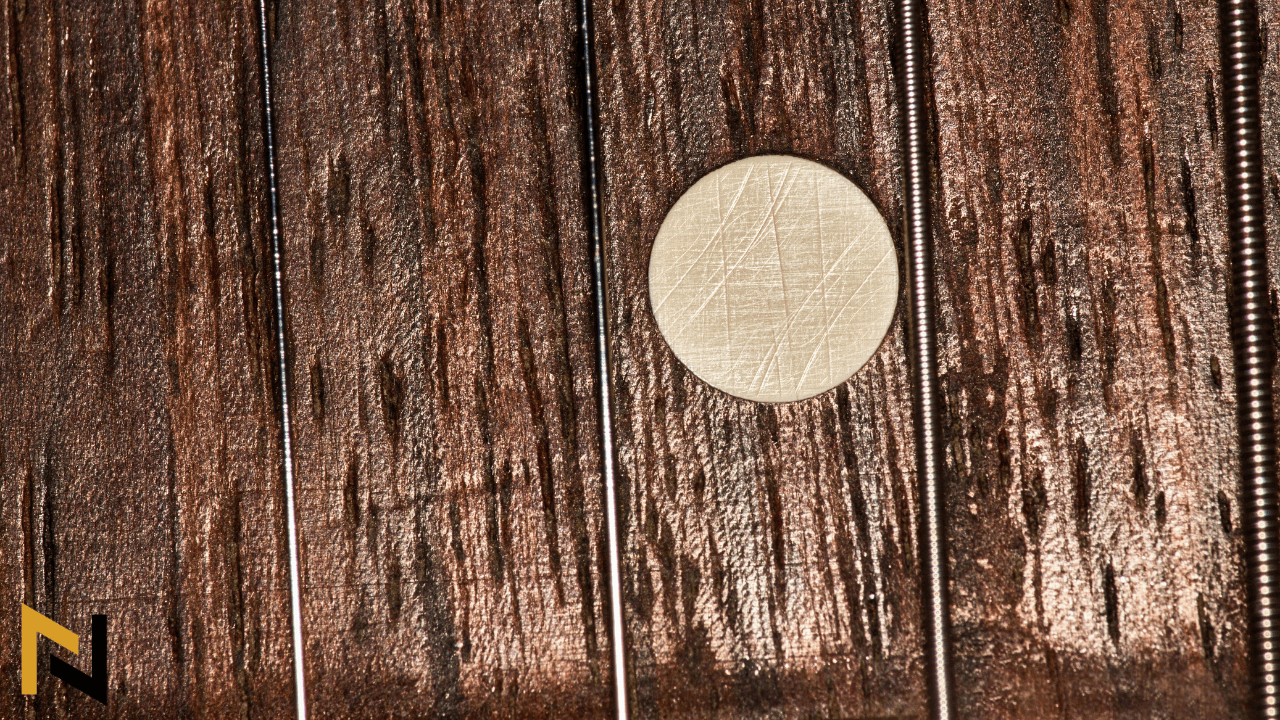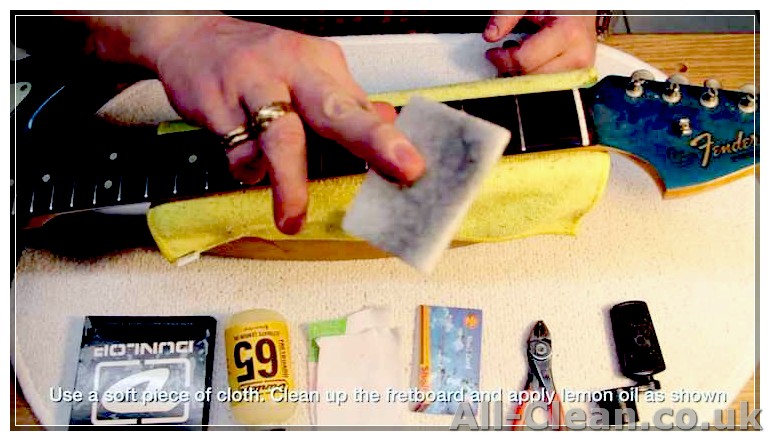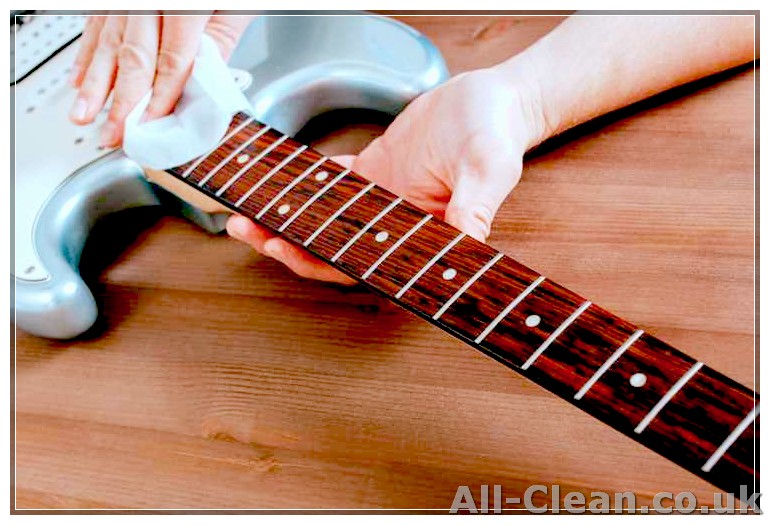
When it comes to maintaining your guitar, cleaning the fretboard is an important task that should not be overlooked. A clean fretboard not only looks better, but it also helps to keep your instrument in top shape and improve playability. Although there are many options for cleaning products available, sometimes the best approach is a simple one.
If you have a guitar with a maple fretboard, cleaning is a bit easier as maple is a hard and smooth wood. Start by removing the strings so that you can have full access to the fretboard. Then, using a soft cloth or sponge, lightly dampened with warm water, rub gently along the length of the neck to remove any grime or dirt that has accumulated. Be sure to work your way down each fret and stop rubbing once the fretboard is clean.
For guitars with rosewood fretboards, it’s important to be a bit more cautious as rosewood is a more porous wood. Before cleaning, check to see if any hydration or humidification is needed for the fretboard. If it’s dry, a light application of lemon oil can help to moisturize and protect the wood. Once the fretboard is properly hydrated, use a soft cloth or sponge to gently remove any dirt or grime from the wood. Make sure to work in the direction of the grain and take care not to apply too much pressure.
Regardless of the type of wood, proper cleaning and maintenance of your guitar fretboard can make a world of difference in the tone and playability of your instrument. Keeping the fretboard clean can prevent dirt and grime from getting into the pores and affecting the sound of your guitar. It’s a simple step that can go a long way in preserving the life of your guitar.
Remember, cleaning your guitar fretboard is not something that needs to be done every week or even every month. It’s more of a “as needed” maintenance task. Depending on how often you play and the conditions your guitar is exposed to, you may find that a cleaning is necessary every few months.
Regardless of how often you clean your guitar fretboard, it’s important to use the right tools and techniques to ensure that you don’t damage the wood or hardware. Take the time to remove the strings and inspect the woods before beginning the cleaning process. If you notice any scratches or other damage, it’s best to consult a professional for repairs.
In conclusion, properly cleaning a guitar fretboard can work wonders for the tone and playability of your instrument. Whether you have a maple or rosewood fretboard, taking the time to remove dirt and grime can make a world of difference in how your guitar sounds and feels. So, don’t neglect your fretboard and make sure to keep it clean and well-maintained for years of playing enjoyment.
What is a Guitar Fretboard?

A guitar fretboard is the part of the guitar that contains the frets, which are typically made of metal. It is the flat, wooden surface that runs along the neck of the guitar and is where the player presses down on the strings to change the pitch of the notes.
The fretboard is an essential component of a guitar, as it helps to determine the playability and tone of the instrument. It is important to keep the fretboard clean and well-maintained to ensure optimal performance.
Tips for Cleaning a Guitar Fretboard
If you notice that your guitar fretboard is dirty or grimy, it’s time to give it a good cleaning. Here are some tips to help you clean your guitar fretboard properly:
- Before cleaning the fretboard, remove all the strings from the guitar for easier access.
- Use a soft cloth or an old toothbrush to remove any loose dirt or debris from the fretboard.
- For stubborn grime, use a guitar-specific cleaner. Avoid using household cleaners or solvents, as they can damage the wood and finish of the fretboard. Follow the manufacturer’s instructions for the specific cleaner you choose.
- Apply a small amount of the fretboard cleaner to a cloth or toothbrush and gently scrub the fretboard. Be careful not to apply too much pressure or scrub too hard, as this can damage the fretboard or loosen the frets.
- Wipe off any excess cleaner with a clean, dry cloth.
- If your fretboard is made of rosewood or other porous woods, you may consider applying a small amount of fretboard conditioner to help moisturize and protect the wood. Again, follow the manufacturer’s instructions for the specific conditioner you choose.
- Once the fretboard is clean and dry, you can restring your guitar and begin playing again.
By following these steps, you can ensure that your guitar fretboard stays clean and well-maintained, which will ultimately prolong the life of your instrument and improve its playability.
Why is Cleaning a Guitar Fretboard Important?
Keeping your guitar’s fretboard clean is an essential part of maintaining the instrument’s overall condition and performance. A dirty fretboard not only affects the playability but can also lead to damage and deterioration of the wood over time.
Here are a few reasons why cleaning your guitar fretboard is important:
- Improves Playability: A dirty fretboard can make it difficult to slide your fingers smoothly along the strings, affecting your technique and overall performance. By cleaning the fretboard, you remove any dirt, grime, or residue that may be hindering your playing.
- Prevents Damage: When debris accumulates on the fretboard, it can cause scratches, dents, or warping. By regularly cleaning your fretboard, you can prevent any potential damage and extend the lifespan of your instrument.
- Preserves Wood Condition: Fretboards made of materials like rosewood are prone to drying out and cracking if not properly cared for. Cleaning the fretboard helps to keep it moisturized by removing any buildup that may be blocking the wood’s pores.
- Enhances Tone: A clean fretboard can improve the tone and sustain of your guitar. The dirt and grime that accumulate over time can dampen the sound and affect the resonance. Cleaning the fretboard allows for better vibration transfer, resulting in a richer and clearer tone.
By regularly cleaning your guitar fretboard, you not only maintain its appearance but also ensure its longevity and optimal performance. It’s a simple yet necessary step in guitar maintenance that every guitarist should take.
Step 1: Gather the Necessary Materials
Before you can start properly cleaning your guitar fretboard, you’ll need to gather a few essential items. Here are the materials you’ll need:
- A clean, damp cloth or microfiber cloth
- A guitar fretboard polish of your choice
- A polishing cloth or an old t-shirt
- A small ball of cotton or a Q-tip
- A small bottle of lemon oil (optional)
When choosing a guitar fretboard polish, you have a few options. Some guitarists prefer to use products specifically designed for fretboard cleaning, such as the Ernie Ball 65 Fretboard Cleaner & Polish. Others may use household items like furniture polish, as long as they are safe for use on wood. Just be careful to avoid using anything that could be harmful to your instrument.
If your fretboard is particularly dirty or has stubborn grime buildup, you might also consider using a small amount of lemon oil. This can help to remove dirt and make the fretboard look like new again. However, it is important to note that lemon oil should only be used occasionally, as excessive use can lead to damage or discolouration of the wood.
It’s also worth noting that not all guitar fretboards require the use of polish or oil. Some types of fretboards, such as those made of maple, are typically left unfinished and should not be oiled. In these cases, a simple wipe down with a damp cloth is usually sufficient.
In addition to the materials listed above, it’s a good idea to have a clean and well-lit workspace. This will make it easier to see any dirt or grime that needs to be removed and ensure that you can properly clean all areas of the fretboard. If possible, place a towel or soft cloth on the body of the guitar to protect it while you work.
Now that you have everything you need, you’re ready to move on to the next step in properly cleaning your guitar fretboard!
What Materials Do You Need?
- A guitar cleaning kit or the following materials:
- A soft cloth or microfiber cloth
- Guitar cleaner or lemon oil
- Guitar polish or fretboard conditioner
- Steel wool or fret cleaning erasers
- Guitar string cleaner
- A small ball of cotton
- Fast fret or other fretboard lubricant
- A small brush or toothbrush
- Distilled water
- Optional materials:
- Guitar humidification device
- Humidifier pack or dampit
Step 2: Remove the Strings

Once you have gathered all the necessary cleaning materials, it’s time to remove the strings from your guitar. This step is crucial as it allows you to properly clean the fretboard without any obstacles getting in the way.
Different guitars may have different types of strings. Some may have longer winding portions, while others may have shorter ones. Regardless, removing the strings is a simple process.
- Start by loosening the tension on each string by turning the tuning pegs.
- Once the strings are no longer tight, you can unwind and remove them from the tuning pegs.
- If your guitar has a rosewood fretboard, take extra care while removing the strings. Rosewood is a softer wood and can easily get scratched or damaged if the strings are pulled forcefully.
- Use a soft cloth or your hand to support the strings as you remove them. This will prevent them from scratching the frets or the finish of the guitar.
- After the strings are removed, set them aside for later use or replacement.
Removing the strings also gives you an opportunity to inspect them for any signs of wear or damage. If you notice any issues, it might be a good time to replace them.
Now that the strings are out of the way, you can move on to the next stage of cleaning your guitar fretboard.
How to Properly Remove the Strings?

Before cleaning your guitar fretboard, you need to remove the strings. This allows you to have better access to the fingerboard and ensures a thorough cleaning. Here’s how to properly remove the strings from your guitar:
- Gather the necessary tools: To remove the strings, you would need a good quality string winder, a pair of wire cutters, and a clean cloth.
- Loosen the tension: Start by loosening the tension of each string. Use the string winder to unwind the strings until they are significantly loose.
- Clip the strings: Once the strings are loose, use the wire cutters to carefully cut each string close to the tuning pegs. Be careful not to damage the guitar body or headstock while cutting.
- Remove the strings: After all the strings are cut, you can remove them one by one by detaching them from the bridge and carefully pulling them out from the tuning pegs. Dispose of the old strings properly.
By following these steps, you can easily remove the strings from your guitar without causing any damage.
Step 3: Clean the Fretboard
Now that you’ve taken care of the strings and body, it’s time to focus on cleaning the fretboard. This step is important because a dirty fretboard can make it difficult to play and can even affect the sound of your guitar.
Here are 4 tips to help you properly clean your fretboard:
- Choose the right cleaning agent: Depending on the kind of wood your fretboard is made of, you’ll need to use a specific cleaner. For example, if your guitar has a rosewood or ebony fretboard, you can use lemon oil. If it has a maple fretboard, a damp cloth will do. Be careful not to use any harmful chemicals or solvents.
- Start with a dry wipe: Before applying any cleaner, use a dry cloth to wipe down the entire fretboard. This will remove any loose dirt or dust particles.
- Clean with the appropriate cleaner: For rosewood or ebony fretboards, apply a small amount of lemon oil on a clean, lint-free cloth. Gently rub the oil into the wood, moving in the direction of the frets. For maple fretboards, simply use a damp cloth to wipe down the surface.
- Wipe off excess cleaner: After cleaning, use a clean cloth to wipe off any excess oil or moisture from the fretboard. This step is important because leaving the wood damp can lead to swelling or warping.
By following these steps, you’ll be able to keep your fretboard clean and well-maintained. Regular cleaning will help protect the wood, extend the life of your guitar, and ensure optimal playability.








